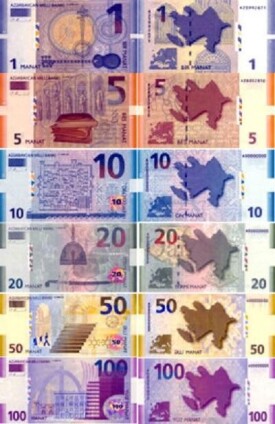亞塞拜然馬納特
亞塞拜然馬納特
亞塞拜然馬納特(Azerbaijani manat) 標準符號:AZN ISO 4217現行通用三位字母代碼:AZM)
ISO 4217 Code:AZN
User(s):Azerbaijan except Nagorno-Karabakh
Inflation:11.5%
Source:National Bank of Azerbaijan, November, 2006
Method:CPI
Subunit:1/100 qəpik
Symbol:m, ман. or man.
Coins:1, 3, 5, 10, 20, 50 qəpik
Banknotes:1, 5, 10, 20, 50, 100 manat
Central bank:National Bank of Azerbaijan
Website:http://www.nba.az
The manat (currency code: AZN) is the currency of Azerbaijan. It is subdivided into 100 qəpik. The word manat is borrowed from the Russian word "монета" (coin) which is pronounced as "maneta". Manat was also the designation of the Soviet ruble in both the Azerbaijani and Turkmen languages.
First Manat, 1919-1923
The Democratic Republic of Azerbaijan and the Azerbaijani Soviet Socialist Republic issued their own currency between between 1919 and 1923. This currency was called the manat (منات) in Azerbaijani and the ruble (рубль) in Russian, with both language appearing on the banknotes. The manat replaced the first Transcaucasian ruble at par and was replaced by the second Transcaucasian ruble after Azerbaijan became part of the Transcaucasian Soviet Federal Socialist Republic. No subdivisions were issued and the currency only existed as banknotes. The Democratic Republic issued notes in denominations between 25 and 500 manat, whilst the ASSR issued notes in denominations between 5 and 5 million manat.
Second Manat, 1992-2006
The second manat was introduced on 15 August, 1992.1 It had the ISO 4217 code AZM and replaced the Russian ruble at a rate of 10 rubles to 1 manat.
From early 2002 to early 2005, the exchange rate was fairly stable (varying within a band of 4770–4990 manat per US dollar). Starting in the spring of 2005 there was a slight but steady increase in the value of the manat against the US dollar; the reason most likely being the increased flow of petrodollars into the country, together with the generally high price of oil on the world market. At the end of 2005, one dollar was worth 4591 manat. Banknotes below 100 manat had effectively disappeared by 2005, as had the qəpik coins.
Coins were issued in denominations of 5, 10, 20 and 50 qəpik, dated 1992 and 1993. Although brass and cupro-nickel were used for some of the 1992 issues, later issues were all in aluminium.
The following banknotes were issued for this currency
● 1, 5, 10, 250 manat (all first issued in 1992)
● 50, 100, 500, 1000 manat (all first issued in 1993)
● 10,000 manat (first issued in 1994)
● 50,000 manat (first issued in 1996)
Banknotes with denominations from 1 to 250 manat featured Baku's maiden Tower.
Third Manat, 2006-
On 1 January 2006, a new manat (ISO 4217 code AZN, also called the "manat (national currency)") was introduced at a value of 5000 old manat. Since 1 October 2005, prices have been indicated both in new manats and in old manats to ease transition. Coins denominated in qəpik, which had not been used from 1993 onwards due to inflation, have been reintroduced with the redenomination.
The former manat (ISO code 4217 AZM) remained valid till 31 December 2006. 2
One U.S. dollar is currently (as of 2006) worth 0.918 Azerbaijani manat.
Coins
Coins in circulation are 1, 3, 5, 10, 20 and 50 qəpik (the latter being bimetallic, similar to the €2 coin)
亞塞拜然馬納特鑄幣1, 3, 5, 10, 20 and 50 qəpik
Banknotes
Banknotes in circulation are 1, 5, 10, 20, 50 and 100 manat. They were designed by Austrian Robert Kalina, who was also responsible for the current euro banknotes. The notes look quite similar to those of the euro and the choice of motifs was inspired by the euro banknotes.
